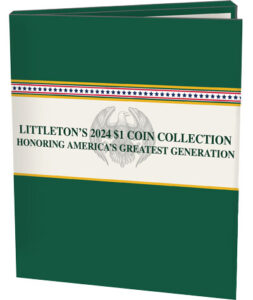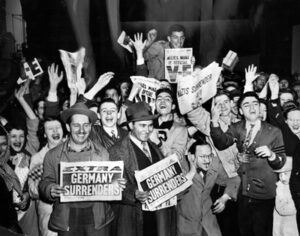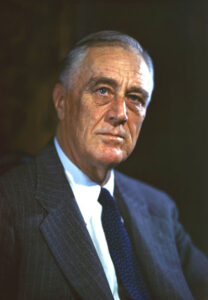Who Were America’s Greatest Generation?
Patriotism. Resourcefulness. Fortitude. Determination. When thinking of the people born in America at the turn of the 20th century, there are many words that spring to mind but perhaps none more so than perseverance. This word was the basis of an entire generation. Born from 1901-1924, this resilient group of Americans found themselves in a time of unprecedented change not only in the United States of America but around the world.
Today we know them as our parents, grandparents and great-grandparents but before they were known by these names, they were called another. They are the Greatest Generation.

Join Littleton Coin Company in celebrating the tribulations and accomplishments of this generation with our new $1-coin series honoring America’s greatest generation. In this 10-coin program, you’ll find coins honoring the Great Depression, New Deal, G.I. Bill, baby boom and so much more!
Coming of age
Born during a time of transformation, the Greatest Generation spent their youth welcoming new states to the country, reveling in the innovations of the turn of the century and – perhaps most important of all – living through the first World War.
A true testament to the spirit of the American people, the “war to end all wars” strengthened the nation’s resolve to solidify the United States’ standing as a world power. World War I brought a sense of unrivaled patriotism that carried the youths of the country through the following decades and into the next millennium.
With the defeat of the Central Powers (Germany, Austria–Hungary, Bulgaria and the Ottoman Empire), came a wave of activism that changed American culture. The coming of age for the Greatest Generation came side-by-side with the right to vote for women, the beginnings of equal rights for African-Americans and a larger say on the world stage.
America’s greatest generation looked forward to a time of peace and hope but destiny had other plans.
The Great Depression
Beginning in 1929 and lasting until 1939, this economic crisis forever changed the lives of those who lived through it. A world-wide event that would take the next decade to stabilize, the uncertainty of each day gave way to a mental fortitude that was necessary to survive.
Soup kitchens became a lifeline for tens of millions of Americans during the Great Depression. Initially run by private churches and charities, the notorious gangster Al Capone even founded a soup kitchen in Chicago to help support the city’s jobless population. The government soon followed suit as a way to help the American people.

To add to the country’s dire situation, severe droughts which would come to be known as the “Dust Bowl,” ravaged the Midwest from 1930-1936. Starvation and “dust pneumonia” were widespread and led to the loss of over 7,000 lives in those six grueling years. This in turn caused more than 400,000 people to flee their homes in search of what little work could be found in cities around the country.
As the years continued to march on, so too did the spirit of the American people who were determined to see a better tomorrow. The process of moving forward began with the election of Franklin Delano Roosevelt as the 32nd president. He won in a landslide in 1932 against incumbent President Herbert Hoover, a feat not easily accomplished. By this point, the American people were deep in the throes of the Great Depression.
“I pledge you, I pledge myself, to a new deal for the American people,” President Roosevelt promised as he was sworn into office in March 1933.
Within his first 100 days in office, President Roosevelt had begun the difficult task of restoring the public’s confidence.
The New Deal provided support to impoverished areas such as the Tennessee River Valley as well as providing bank reforms, work relief programs and more. With the implementation of this program, Americans were able to begin pulling themselves out of the Great Depression and look towards the future.
World War II
While the people of the United States had been working to recover from the Depression, trouble was brewing in Europe. In September of 1939, the second World War had begun with Germany’s invasion of Poland.

The young men of the Greatest Generation flocked to enlist.
The events twenty years prior were still fresh. America’s greatest generation, who had spent their youth with the sounds of the first World War in the background, was ready to take a stand for freedom. While the men signed up to fight, the young women of their generation would not be left behind quietly.
Women filled the roles that had been left open and quickly adapted to this new way of life.
Overseas, the military found two hundred thousand women ready to serve in addition to the over three million women volunteering for the Red Cross. Determined not to be left on the sidelines back home, there were more than six million women who went to work in factories in support of the war efforts. At the end of the day, there were more than nine million women who proudly joined the workforce ready to support their country and families.
By the end of the war in 1945, life would not be the same for this impressive generation.
After the war

As the war drew to a close, over eight million servicemen and women were brought back home to the United States with Operation Magic Carpet. As a way of thanking those who had served, the G.I. Bill was signed on June 22, 1944 by President Franklin D. Roosevelt.
By authorizing the G.I. Bill, it ensured that those heroes returning home would be provided for with funds for college education, unemployment insurance and housing. The effects of which can still be felt in today’s G.I. Bill for America’s heroes.
The reunions of those who served overseas, with those left behind, resulted in the baby boom that would, in their own generation, alter the trajectory of the United States. America’s greatest generation would go on to see the Civil Rights Act of 1964 ratified, the landing of man on the moon and countless other moments of change in the country and around the world.
The Greatest Generation had proved themselves time and time again as the dictionary definition of resilient, determined and persevering. Littleton Coin Company is honored to celebrate them with our exclusive $1-coin series.
Tell us who in your life is a member of the Greatest Generation! Which coin(s) are you looking forward to? Who will you be celebrating our new $1-coin series with?
Sources:
Kiger, Patrick J. “5 Causes of the Great Depression” Accessed January 2, 2024. https://www.history.com/news/great-depression-causes
Klein, Christopher. “Mobster Al Capone Ran a Soup Kitchen During the Great Depression” Accessed January 2, 2024. https://www.history.com/news/al-capone-great-depression-soup-kitchen
“Great Depression History” Accessed January 2, 2024. https://www.history.com/topics/great-depression/great-depression-history
Library of Congress. “The Dust Bowl” Accessed January 8, 2024. https://www.loc.gov/classroom-materials/united-states-history-primary-source-timeline/great-depression-and-world-war-ii-1929-1945/dust-bowl/
Library of Congress. “President Franklin Delano Roosevelt and the New Deal” Accessed January 2, 2024. https://www.loc.gov/classroom-materials/united-states-history-primary-source-timeline/great-depression-and-world-war-ii-1929-1945/franklin-delano-roosevelt-and-the-new-deal/
The National WWII Museum. “Research Starters: Women in World War II” Accessed January 3, 2024. https://www.nationalww2museum.org/students-teachers/student-resources/research-starters/research-starters-women-world-war-ii
Makamson, Collin. “Home Alive by ‘45’: Operation Magic Carpet” Accessed January 2, 2024. https://www.nationalww2museum.org/war/articles/operation-magic-carpet-1945



